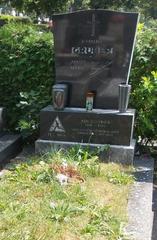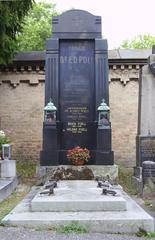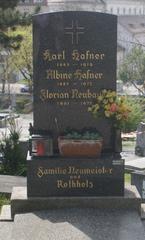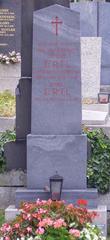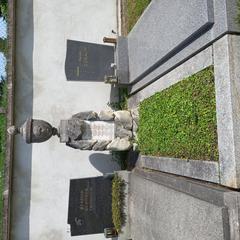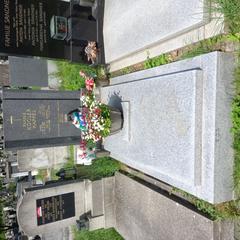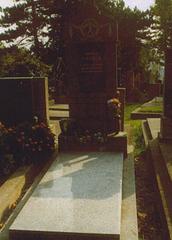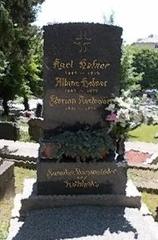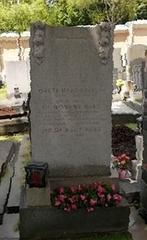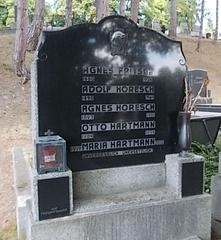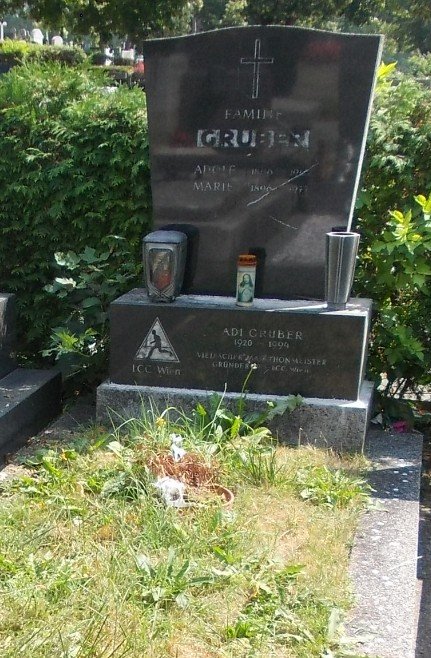
Hernalser Friedhof Visiting Hours, Tickets, and Vienna Historical Sites Guide
Date: 15/06/2025
Introduction: Vienna’s Historic Green Oasis
Nestled on the gentle slopes of Schafberg in Vienna’s 17th district, Hernalser Friedhof is more than a cemetery—it is a peaceful green oasis, a testament to Vienna’s multicultural heritage, and an open-air museum of funerary art and architecture. Established between 1870 and 1872 under the direction of architect Johann Pflaum, Hernalser Friedhof was conceived to serve a rapidly expanding city while preserving and honoring the burial traditions of the Hernals district. Today, it stands as a tranquil yet vibrant space, welcoming visitors interested in history, architecture, and local culture (Austria-Forum, GeschichteWiki, grabsteineposch.at, Evendo).
The cemetery’s neo-Gothic chapel, distinctive horseshoe layout, and a rich collection of grave monuments reflect the evolving artistic styles and social history of Vienna. Open daily from early morning to sunset, with free entry and accessible pathways, Hernalser Friedhof is an inclusive destination for contemplation, exploration, and community events (viennatouristguide.at, Benu).
This guide provides detailed information on Hernalser Friedhof’s history, architecture, visiting hours, accessibility, and practical tips, making it easy to plan a meaningful visit to one of Vienna’s hidden historical gems.
Historical Overview
Origins and Early Burial Grounds
The origins of Hernalser Friedhof date back to the parish graveyard near Kalvarienbergkirche, serving the Hernals community until 1784. Emperor Joseph II’s reforms closed inner-city cemeteries, prompting the creation of a new burial ground near today’s Lorenz-Bayer-Platz. By the 1830s, this site had expanded—partly due to cholera outbreaks—and remained in use until 1872, after which it was converted into a public park (Austria-Forum).
Establishment and Architectural Design (1870–1872)
Rapid urban growth in the 19th century led to the construction of the modern Hernalser Friedhof. Architect Johann Pflaum designed the cemetery on Schafberg’s slopes, inspired by Munich’s Aktienfriedhof, featuring a horseshoe-shaped layout with a central axis and side arms (GeschichteWiki). The neo-Gothic chapel, built between 1870 and 1872, became the architectural centerpiece, with arcaded crypts and terraces ascending the hillside to provide both function and grandeur (Benu).
Expansion and Artistic Heritage
Over the decades, the cemetery expanded several times, growing from 49,080 square meters in 1891 to over 160,000 square meters today (Austria-Forum). The site features a remarkable collection of funerary art—including Gothic Revival, Art Nouveau, and Neoclassical grave monuments—reflecting both the artistic trends and the multicultural fabric of Vienna (grabsteineposch.at, Evendo). Memorials such as the field marshal Clerfayt’s tomb and crosses for the victims of fascism highlight the cemetery’s role in commemorating local and national history.
Restoration efforts in the late 20th and early 21st centuries have preserved the site’s historical monuments and enhanced accessibility, ensuring that Hernalser Friedhof remains both a place of remembrance and a living part of Vienna’s heritage.
Visitor Information
Visiting Hours
Hernalser Friedhof operates with seasonal hours to accommodate daylight changes:
- January & February: 8:00 – 17:00
- March: 7:00 – 18:00
- April to September: 7:00 – 19:00
- October, All Saints’ Day, All Souls’ Day: 7:00 – 18:00
- From November 3rd & December: 8:00 – 17:00
- Thursdays (May to August): Extended hours until 20:00
The cemetery office is open Monday to Saturday, 8:00–15:00 (viennatouristguide.at).
Tickets and Entry
Entry is free; no tickets or reservations are needed. Donations for cemetery upkeep are appreciated and can be made at the office.
Accessibility
Main paths are paved and accessible for wheelchairs, though some terraced areas may be challenging. Wheelchair users are advised to contact the administration in advance if additional assistance is needed. Guide dogs are permitted; other pets are not.
Getting There
- Address: Leopold-Kunschak-Platz 7, 1170 Vienna
- Public Transport:
- Tram lines 43 and 44: “Hernalser Friedhof” stop
- Bus lines 10A, 42A, 44A, N43, 445: Nearby stops
- Driving: Limited street parking is available; public transport is recommended for convenience.
Site Layout and Architectural Highlights
Cemetery Design
Hernalser Friedhof features a central avenue lined with mature trees and symmetrical grave plots, creating a park-like setting that blends built and natural elements. Terraced sections, arcaded crypts, and decorative mausoleums contribute to the cemetery’s harmonious atmosphere (grabsteineposch.at).
Neo-Gothic Chapel and Crypt Arcades
The main entrance leads to the striking neo-Gothic chapel, built with exposed brickwork and adorned with pointed arches, stained glass, and ornamental details. Adjacent crypt arcades house family tombs and notable monuments, serving as both shelter and galleries of funerary art.
Artistic Grave Monuments
Visitors will encounter a diverse array of grave markers, from allegorical sculptures and Art Nouveau headstones to simple, hand-carved memorials. These monuments illustrate Vienna’s artistic evolution and the city’s multicultural social history (Evendo).
Memorials and Green Spaces
The cemetery includes memorials for victims of fascism and other symbolic features such as laurel wreaths, nature carvings, and religious statues. Lush landscaping and well-maintained paths invite visitors to reflect and enjoy the serene environment. Benches are placed throughout for rest and contemplation.
Community Role and Cultural Significance
Multicultural and Social Heritage
Hernalser Friedhof reflects the ethnic and religious diversity of Vienna during the Austro-Hungarian Empire. Inscriptions in multiple languages and sections for different faiths highlight its inclusive nature. The cemetery serves as the final resting place for politicians, artists, entrepreneurs, and everyday citizens, with grave monuments representing personal stories and broader community evolution (Evendo).
Notable Burials and Local Memory
Among the cemetery’s notable graves are those of philosopher Günther Anders, writer Konrad Bayer, football legend Ernst Happel, musician Hansi Lang, and actress Brigitte Neumeister. The imposing Clerfayt monument and other honorary graves further underscore its historical importance (Benu, Vienna Tourist Guide).
Events, Tours, and Musical Heritage
Seasonal guided tours and special events—such as musical performances honoring the district’s Schrammelmusik tradition—enrich the visitor experience. Programs like “Musikalische Friedhofsgeschichten” combine storytelling and music to celebrate Hernals’ cultural legacy (Peter Havlicek).
Urban Green Space
Beyond its role as a burial ground, Hernalser Friedhof serves as a community park, supporting biodiversity and offering a peaceful retreat for reflection, walking, and quiet recreation.
Practical Tips and Visitor Etiquette
- Restrooms: Available near the entrance for a small fee; bring coins.
- Water Points: Located throughout for floral tributes.
- Photography: Permitted for personal use; avoid photographing mourners and be respectful at all times.
- Dress and Behavior: Modest attire and quiet conduct are expected; greet staff or visitors with “Grüß Gott” or a simple hello.
- Pets: Only guide dogs are allowed on the grounds.
- Children: Welcome but should be supervised.
Nearby Attractions and Travel Tips
While in Hernals, explore local cafés, the historic Kalvarienbergkirche, Schafberg Park, or venture to other notable Vienna cemeteries like Zentralfriedhof. The district’s charming atmosphere makes it ideal for combining historical exploration with culinary and cultural experiences.
Frequently Asked Questions (FAQ)
Q: What are Hernalser Friedhof’s opening hours?
A: The cemetery is open daily; hours vary seasonally from 7:00 or 8:00 until 17:00–19:00, with extended hours on summer Thursdays.
Q: Is there an entry fee or are tickets required?
A: No, entry is free.
Q: Is the cemetery accessible for visitors with disabilities?
A: Main paths are accessible; some areas are sloped. Contact the office for assistance.
Q: How do I get there by public transport?
A: Tram lines 43 and 44, and bus lines 10A, 42A, 44A, N43, and 445 stop nearby.
Q: Are guided tours available?
A: Occasional tours and events are organized; check with the cemetery office or local tourism websites.
Q: Are restrooms available?
A: Yes, near the main entrance for a small fee.
Q: Are pets allowed?
A: Only guide dogs are permitted.
Visual and Interactive Resources
For digital maps, virtual tours, and more images, visit the Vienna Tourist Guide website.
Summary and Recommendations
Hernalser Friedhof masterfully blends history, art, and community life. Its origins in Vienna’s urban expansion, multicultural layout, and impressive funerary art make it a compelling destination for cultural and historical exploration (Austria-Forum, GeschichteWiki). Free admission, accessible facilities, and a tranquil setting ensure a rewarding visit, whether for quiet reflection or cultural discovery (grabsteineposch.at, Evendo). To enhance your experience, consider using the Audiala app for audio guides, and check local listings for special tours and events (Peter Havlicek, Vienna Tourist Guide).
Official Sources
- Austria-Forum: Hernalser Friedhof
- GeschichteWiki: Hernalser Friedhof
- Evendo: Hernals Cemetery
- Vienna Tourist Guide
- Grabsteine Posch
- Benu
- Peter Havlicek: Musikalische Friedhofsgeschichten
For more Vienna travel inspiration and updates, download the Audiala app, explore related articles on Vienna’s cemeteries and architecture, and follow our social media channels.
